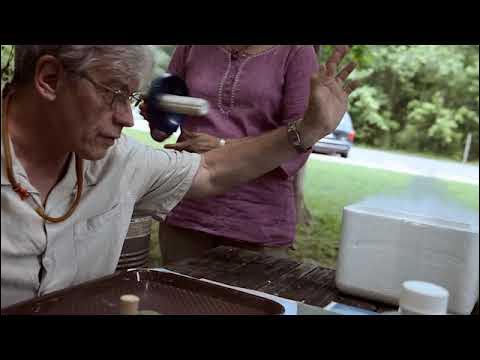Collecting the World: Inside the Smithsonian
Summary
TLDRThe video script introduces Kirk Johnson, the director of the Smithsonian's National Museum of Natural History, who oversees over 144 million objects. The script highlights the museum's vast collections, including specimens from the Division of Birds, butterflies, mollusks, minerals, and entomology. It emphasizes the scientific importance of these collections in understanding biodiversity, improving aviation safety, studying global climate change, and preserving Earth's history for future generations.
Takeaways
- 🎥 The Smithsonian National Museum of Natural History holds over 144 million objects.
- 🦄 One of these objects includes a narwhal tusk.
- 🦸♂️ Kirk Johnson is in charge of all these collections, and 99% of them are stored behind the scenes.
- 🐦 Carla Dove from the Division of Birds works with around 620,000 bird specimens, which represent 85% of global bird diversity.
- 🛬 Bird specimens help improve aviation safety by identifying birds that collide with airplanes.
- 🦋 Dr. Bob Robbins has been studying butterflies for 35 years and emphasizes the hidden, fascinating world of butterflies and its value to humans.
- 🐚 Ellen Strong, curator of mollusks, oversees a collection that may contain up to 20 million specimens, preserving past and present life for future generations.
- 💎 Dr. Jeff Post, curator of the national gem and mineral collection, manages minerals ranging from recent formations to those over 3 billion years old.
- 🌍 The collection contains more than half of the 5,000 known Earth minerals, helping scientists piece together how the planet works.
- 🦟 Floyd Shockley manages over 35 million insect specimens, which help answer big questions like global climate change and habitat destruction.
Q & A
What is the main focus of the Smithsonian's National Museum of Natural History?
-The Smithsonian's National Museum of Natural History focuses on preserving and studying over 144 million objects that represent the natural world, with most of its collections housed behind the scenes.
What is the role of Kirk Johnson at the museum?
-Kirk Johnson is responsible for overseeing all of the collections at the Smithsonian's National Museum of Natural History.
What significant work does Carla Dove from the Division of Birds focus on?
-Carla Dove uses bird specimens to study bird collisions with airplanes, which helps improve aviation safety.
What has been Dr. Bob Robbins' contribution to the museum as a lepidopterist?
-Dr. Bob Robbins has spent over 35 years studying butterflies and works as a lepidopterist, contributing to the understanding of butterflies and their broader importance to human beings.
Why does Ellen Strong consider her role as curator of mollusks important?
-Ellen Strong values her role because the mollusk collection preserves a comprehensive record of past and present life on Earth, which is crucial for future study and posterity.
What does the mineral collection, curated by Dr. Jeff Post, reveal about Earth's history?
-The mineral collection includes specimens that range from tens of years old to over three billion years old, helping researchers understand Earth's processes and history through its 5,000+ types of minerals.
How many insect specimens are housed in the entomology collection, and what significance does it hold?
-The entomology collection contains over 35 million insect specimens, representing about one-third of all insect life on Earth. This vast collection allows scientists to explore big questions like global climate change and habitat destruction.
Why are large collections of specimens essential for answering global scientific questions?
-Large collections provide a comprehensive view of biodiversity over time, which is crucial for addressing large-scale issues like climate change, habitat destruction, and species conservation.
How do the museum's collections contribute to solving real-world problems?
-The museum's collections provide scientific data that contribute to solving problems like food shortages, disease outbreaks, and aviation safety by preserving and studying specimens from the natural world.
What is the overarching goal of the Smithsonian's National Museum of Natural History according to the video?
-The museum aims to collect, preserve, and study specimens from the natural world to better understand Earth and its living systems, and to provide practical solutions to global challenges.
Outlines

Dieser Bereich ist nur für Premium-Benutzer verfügbar. Bitte führen Sie ein Upgrade durch, um auf diesen Abschnitt zuzugreifen.
Upgrade durchführenMindmap

Dieser Bereich ist nur für Premium-Benutzer verfügbar. Bitte führen Sie ein Upgrade durch, um auf diesen Abschnitt zuzugreifen.
Upgrade durchführenKeywords

Dieser Bereich ist nur für Premium-Benutzer verfügbar. Bitte führen Sie ein Upgrade durch, um auf diesen Abschnitt zuzugreifen.
Upgrade durchführenHighlights

Dieser Bereich ist nur für Premium-Benutzer verfügbar. Bitte führen Sie ein Upgrade durch, um auf diesen Abschnitt zuzugreifen.
Upgrade durchführenTranscripts

Dieser Bereich ist nur für Premium-Benutzer verfügbar. Bitte führen Sie ein Upgrade durch, um auf diesen Abschnitt zuzugreifen.
Upgrade durchführenWeitere ähnliche Videos ansehen

Natural History Museum - Full Tour - Washington, DC - Smithsonian 4K

From 2000: Mementos at the Wall

Museum Nasional Indonesia dalam Dimensi Waktu | Narasi Explains

The Importance Of Museums - "In The New Era Of Social Media" - (Official Documentary) [HD]

READINGS IN PHILIPPINE HISTORY- MEANING OF HISTORY,SOURCES OF HISTORICAL DATA & HISTORICAL CRITICISM

Unit 6 Life on Ice (Reading Explorer 5 - 3rd Edition)
5.0 / 5 (0 votes)
